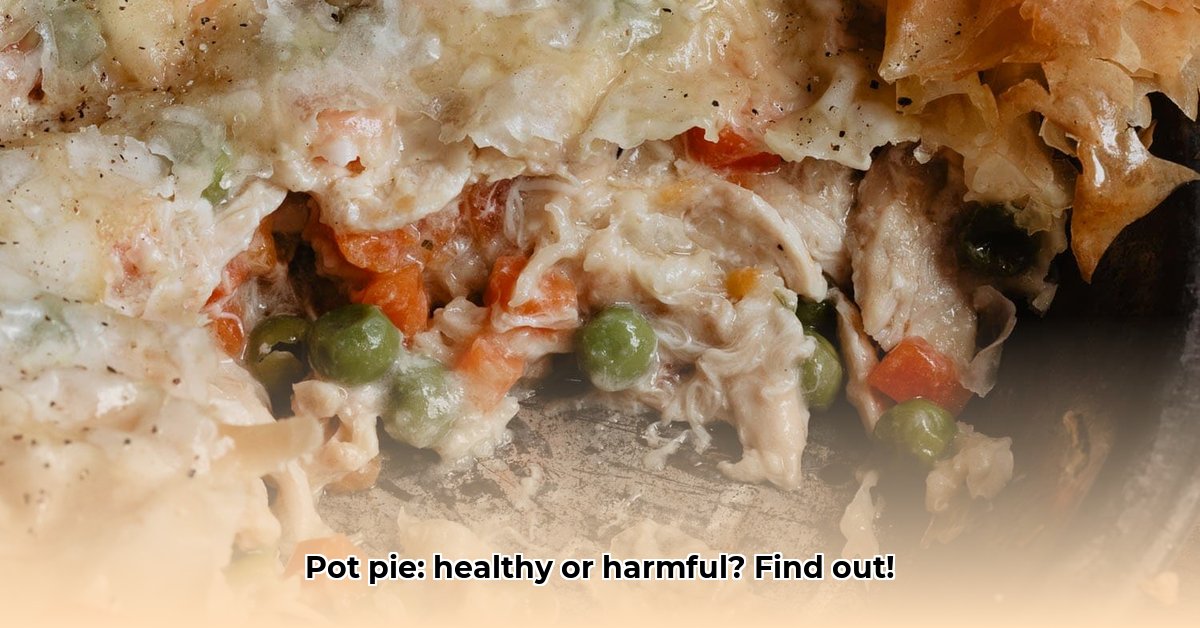Love pot pie but worried about the health impact? You’re not alone! Everyone enjoys a comforting pot pie now and then, but let’s be honest, some are definitely healthier than others. This review digs into the world of pot pies, looking at what’s in them and helping you choose the best options for your diet. We’ll compare different brands, talk about making your own at home, and give you simple tips for making healthier choices, so you can enjoy your pot pie guilt-free. For more healthy eating tips, check out this 7-day healthy eating plan.
Is it Healthy to Eat Pot Pie and still maintain optimal wellness?
Let’s be honest, pot pie is comfort food perfection. That flaky crust and the savory filling are irresistible! But is indulging in this classic dish a health hazard? The answer, as with most things food-related, isn’t a simple yes or no; it’s nuanced, and it really depends on what’s in that pie and if your goal of maintaining optimal wellness.
Unpacking the Frozen Pot Pie Phenomenon: A Look at Convenience Foods
Frozen pot pies reign supreme in the convenience food arena. They’re readily available, super easy to whip up, and undeniably satisfying on a chilly evening. However, this convenience often comes with a nutritional trade-off. Many commercially produced frozen pot pies are packed with sodium, unhealthy saturated fats, and added sugars—ingredients that, in excess, aren’t exactly doing your health any favors. Think heart health, blood pressure, and blood sugar levels. These are all areas where a diet high in these things can cause problems, but you can still indulge with the right pot pie dietary information.
A Nutritional Showdown: Comparing Brands (and Portions!) for Informed Eating
To get a clearer picture, let’s dive into the nutritional details of some popular frozen pot pie brands. This isn’t an exhaustive list, but it gives you a good sense of the variations. Remember, portion size plays a huge role in the overall nutritional impact. A smaller serving of even a high-sodium pie might be less damaging to your health than a larger serving of a low-sodium one.
| Brand (Example) | Sodium (mg) (per serving) | Saturated Fat (g) (per serving) | Added Sugar (g) (per serving) | Overall Health Impact |
|---|---|---|---|---|
| Brand A (High Sodium) | >700 | >8 | >4 | High Risk |
| Brand B (Moderate) | 500-700 | 5-8 | 2-4 | Moderate Risk |
| Brand C (Lower Sodium) | <500 | <5 | <2 | Lower Risk |
Note: These values are illustrative examples based on average analyses. Always check the specific nutrition facts panel on the packaging of the particular pie and serving size you are considering. Don’t just glance; really read the numbers and look at pot pie nutrition facts.
High levels of sodium, saturated fat, and added sugars aren’t ideal for long-term health. Think high blood pressure, increased risk of heart disease, and potential weight gain. It’s all interconnected.
Homemade vs. Store-Bought: A Balancing Act for Dietary Lifestyle
Making your own pot pie offers ultimate control over ingredients. You can opt for a whole-wheat crust (more fiber!), leaner meats (like chicken breast instead of sausage), and plenty of fresh vegetables. This significantly improves the nutritional profile. However, homemade pot pies require more time and effort – a considerable investment if you’re short on time. It’s a classic trade-off: health versus convenience. What’s more important to you and your pot pie dietary lifestyle?
Smart Choices: Navigating the Pot Pie Landscape for Optimal Nutrition
Whether you choose a store-bought or homemade approach, some strategies can help you make healthier selections:
- Become a Nutrition Label Detective: Scrutinize the nutrition label. Pay close attention to the sodium, saturated fat, and added sugar content per serving.
- Choose Wisely: Select brands that are lower in those potentially harmful ingredients. It might mean paying a bit more, but your health is worth it; prioritize healthier pot pie brands.
- Portion Control is King: Smaller servings significantly reduce the total amount of unhealthy ingredients you consume. A smaller serving of a less-healthy pie might actually be a better choice than a large serving of a slightly healthier one.
- Homemade Magic: If time allows, baking your own pot pie gives you complete control—enabling adjustments for a healthier outcome and healthy pot pie recipes.
- Don’t Get Tricked by “Low-Calorie” Labels: Calories aren’t the whole story. A low-calorie pie might still be packed with sodium or unhealthy fats. Focus on the overall nutritional picture.
The Verdict? Is it healthy to eat pot pie? The answer is a resounding “it depends.” But by making informed choices, opting for healthier brands, watching your portion sizes, and considering homemade alternatives, you can enjoy the comforting goodness of pot pie without sacrificing your health goals completely. Moderation is key! Enjoy it as an occasional treat, not a daily staple. Ongoing research may continue to refine our understanding of the impacts of specific pot pie ingredients, so stay informed! Frozen pot pies vary widely in nutritional content, with some surprisingly healthy. However, sodium, added sugar, and saturated fat are key areas to watch.
How to Choose the Healthiest Frozen Pot Pie Brand for your lifestyle
Key Takeaways:
- Frozen pot pies vary widely in nutritional content. Some are surprisingly healthy; others, not so much.
- Sodium, added sugar, and saturated fat are key areas to watch.
- Carefully examine nutrition labels to make informed decisions.
- Lower-sodium options often exist, but you need to hunt for them.
Understanding the Frozen Pot Pie Landscape and Healthy Eating
Let’s face it: frozen pot pie is convenient. But is it healthy? The answer is nuanced. It depends entirely on the brand and, to a lesser extent, the type of pie you choose. Some frozen pot pies are veritable nutritional minefields, packed with sodium and unhealthy fats. Others offer a surprisingly respectable nutritional profile. “It’s about making informed choices,” said Dr. Emily Carter, Registered Dietitian, Nutrition Specialist at Wellness Solutions Institute. So, how to choose the healthiest frozen pot pie brand? It starts with understanding what to look for in healthy frozen meals.
Nutritional Comparisons: A Closer Look for The Right Pot Pie
This isn’t a simple “good” or “bad” equation. Instead, think of it as a spectrum. We’ll use sodium content as a primary indicator because high sodium contributes to many health complications. Consider the pot pie ingredients to make a good decision.
| Brand | Approximate Sodium (mg) per serving | Added Sugar (g) per serving | Saturated Fat (g) per serving | Overall Assessment |
|---|---|---|---|---|
| Blake’s/Boomerang’s | <500 | <3 | Variable | Relatively healthy |
| Dollar Tree/Banquet | >700 | Variable | Variable | Less healthy |
| Marie Callender’s | Variable | Variable | Variable | Varies by specific pie |
Note: These values are estimates based on available data and can vary slightly depending on the specific pot pie variant. Always check the nutrition facts label and aim for low sodium pot pie.
Decoding the Nutrition Label: Your Secret Weapon for Choosing the Right Nutrition
The nutrition label is your guide. Before tossing a pie into your cart, scrutinize it carefully. Pay close attention to:
- Sodium: Aim for options below 500mg per serving.
- Added Sugars: Less is always better. Look for pies with 3g or less.
- Saturated Fat: Higher saturated fat often comes with a traditional crust. Crustless varieties may be a healthier choice.
- Ingredients: Check for high-quality ingredients, avoiding things like “mechanically separated chicken.”
Homemade vs. Frozen: Weighing the Options and Cooking Style
Making your own pot pie offers complete control over ingredients. You can use leaner meats, wholesome vegetables, and reduce sodium and added sugar. However, it takes time and effort. Frozen pies offer convenience, but you must carefully select a healthier option from the array available, consider this pot pie review for help.
Beyond the Basics for Pot Pie Lovers
Remember, portion control is key. Even the healthiest frozen pot pie is better enjoyed in moderation, enjoy pot pie responsibly.
Making Healthier Pot Pie Choices at Home for Weight Management
Key Takeaways:
- Pot pie nutritional value varies wildly depending on ingredients, preparation, and brand.
- Commercial pot pies often have high sodium, saturated fat, and added sugars.
- Homemade versions give you much greater control.
- Making Healthier Pot Pie Choices at Home for Weight Management involves careful ingredient selection and portion control.
Decoding the Pot Pie Puzzle: Frozen vs. Homemade and Nutrition Awareness
Let’s face it: pot pie is comfort food. But can it be part of a weight management plan? Absolutely
- Bento Box Glass Offers Practical, Eco-Friendly Meal Storage - December 16, 2025
- The Best Bento Box Price For Your Perfect Packed Lunch - December 15, 2025
- Bento Box Shopping Tips for Smart and Stylish Lunch Prep - December 14, 2025










